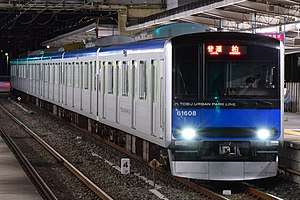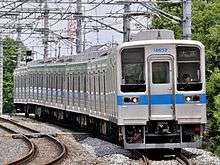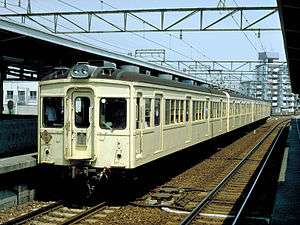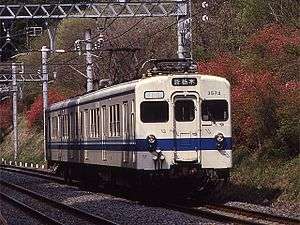Tobu Urban Park Line
The Tobu Urban Park Line (東武アーバンパークライン, Tōbu Ābanpāku-rain), formally known as the Tobu Noda Line (東武野田線, Tōbu Noda-sen), is a 62.7 km (39.0 mi) long railway line in Saitama and Chiba Prefectures operated by the Japanese private railway company Tobu Railway. It connects the satellite cities of Tokyo, such as Saitama, Kasukabe, Noda, Nagareyama, Matsudo, Kamagaya, Kashiwa, and Funabashi.[2]
| Tobu Urban Park Line | ||||||||||||||||||||||||||||||||||||||||||||||||||||||||||||||||||||||||||||||||||||||||||||||||||||||||||||||||||||||||||||||||||||||||||||||||||||||||||||||||||||||||||||||||||||||||||||||||||||||||||||||||||||||||||||||||||||||||||||||||||||||||||||||||||||||||||||||||||||||||||||||||||||||||||||||||||||||||||||||||||||||||||||||||||||||||||||||||||||||||||||||||||||||||||||||||||||||||||||||||||||||||||||||||||||||||||||||||||||||||||||||||||||||||||||||||||||||||||||||||||||||||||||||||||||||||||||||||||||||||||||||||||||||||||||||||||||||||||||||||||||||||||||||||
|---|---|---|---|---|---|---|---|---|---|---|---|---|---|---|---|---|---|---|---|---|---|---|---|---|---|---|---|---|---|---|---|---|---|---|---|---|---|---|---|---|---|---|---|---|---|---|---|---|---|---|---|---|---|---|---|---|---|---|---|---|---|---|---|---|---|---|---|---|---|---|---|---|---|---|---|---|---|---|---|---|---|---|---|---|---|---|---|---|---|---|---|---|---|---|---|---|---|---|---|---|---|---|---|---|---|---|---|---|---|---|---|---|---|---|---|---|---|---|---|---|---|---|---|---|---|---|---|---|---|---|---|---|---|---|---|---|---|---|---|---|---|---|---|---|---|---|---|---|---|---|---|---|---|---|---|---|---|---|---|---|---|---|---|---|---|---|---|---|---|---|---|---|---|---|---|---|---|---|---|---|---|---|---|---|---|---|---|---|---|---|---|---|---|---|---|---|---|---|---|---|---|---|---|---|---|---|---|---|---|---|---|---|---|---|---|---|---|---|---|---|---|---|---|---|---|---|---|---|---|---|---|---|---|---|---|---|---|---|---|---|---|---|---|---|---|---|---|---|---|---|---|---|---|---|---|---|---|---|---|---|---|---|---|---|---|---|---|---|---|---|---|---|---|---|---|---|---|---|---|---|---|---|---|---|---|---|---|---|---|---|---|---|---|---|---|---|---|---|---|---|---|---|---|---|---|---|---|---|---|---|---|---|---|---|---|---|---|---|---|---|---|---|---|---|---|---|---|---|---|---|---|---|---|---|---|---|---|---|---|---|---|---|---|---|---|---|---|---|---|---|---|---|---|---|---|---|---|---|---|---|---|---|---|---|---|---|---|---|---|---|---|---|---|---|---|---|---|---|---|---|---|---|---|---|---|---|---|---|---|---|---|---|---|---|---|---|---|---|---|---|---|---|---|---|---|---|---|---|---|---|---|---|---|---|---|---|---|---|---|---|---|---|---|---|---|---|---|---|---|---|---|---|---|---|---|---|---|---|---|---|---|---|---|---|---|---|---|---|---|---|---|---|---|---|---|---|---|---|---|---|---|---|---|---|---|---|---|---|---|---|---|---|---|---|---|---|---|---|---|---|---|---|---|---|---|---|---|---|---|---|---|---|---|---|---|---|---|---|---|---|---|---|---|---|---|---|---|---|---|---|---|---|---|---|---|---|---|---|---|---|---|---|---|---|---|---|---|---|---|---|---|---|---|---|---|---|---|---|---|---|---|---|---|---|---|---|---|---|---|---|---|---|---|---|---|---|---|---|---|---|---|---|---|---|---|---|---|---|---|---|---|---|---|---|---|---|
| TD | ||||||||||||||||||||||||||||||||||||||||||||||||||||||||||||||||||||||||||||||||||||||||||||||||||||||||||||||||||||||||||||||||||||||||||||||||||||||||||||||||||||||||||||||||||||||||||||||||||||||||||||||||||||||||||||||||||||||||||||||||||||||||||||||||||||||||||||||||||||||||||||||||||||||||||||||||||||||||||||||||||||||||||||||||||||||||||||||||||||||||||||||||||||||||||||||||||||||||||||||||||||||||||||||||||||||||||||||||||||||||||||||||||||||||||||||||||||||||||||||||||||||||||||||||||||||||||||||||||||||||||||||||||||||||||||||||||||||||||||||||||||||||||||||||
 Tobu 60000 series at Unga station, September 2019 | ||||||||||||||||||||||||||||||||||||||||||||||||||||||||||||||||||||||||||||||||||||||||||||||||||||||||||||||||||||||||||||||||||||||||||||||||||||||||||||||||||||||||||||||||||||||||||||||||||||||||||||||||||||||||||||||||||||||||||||||||||||||||||||||||||||||||||||||||||||||||||||||||||||||||||||||||||||||||||||||||||||||||||||||||||||||||||||||||||||||||||||||||||||||||||||||||||||||||||||||||||||||||||||||||||||||||||||||||||||||||||||||||||||||||||||||||||||||||||||||||||||||||||||||||||||||||||||||||||||||||||||||||||||||||||||||||||||||||||||||||||||||||||||||||
| Overview | ||||||||||||||||||||||||||||||||||||||||||||||||||||||||||||||||||||||||||||||||||||||||||||||||||||||||||||||||||||||||||||||||||||||||||||||||||||||||||||||||||||||||||||||||||||||||||||||||||||||||||||||||||||||||||||||||||||||||||||||||||||||||||||||||||||||||||||||||||||||||||||||||||||||||||||||||||||||||||||||||||||||||||||||||||||||||||||||||||||||||||||||||||||||||||||||||||||||||||||||||||||||||||||||||||||||||||||||||||||||||||||||||||||||||||||||||||||||||||||||||||||||||||||||||||||||||||||||||||||||||||||||||||||||||||||||||||||||||||||||||||||||||||||||||
| Native name | 東武アーバンパークライン | |||||||||||||||||||||||||||||||||||||||||||||||||||||||||||||||||||||||||||||||||||||||||||||||||||||||||||||||||||||||||||||||||||||||||||||||||||||||||||||||||||||||||||||||||||||||||||||||||||||||||||||||||||||||||||||||||||||||||||||||||||||||||||||||||||||||||||||||||||||||||||||||||||||||||||||||||||||||||||||||||||||||||||||||||||||||||||||||||||||||||||||||||||||||||||||||||||||||||||||||||||||||||||||||||||||||||||||||||||||||||||||||||||||||||||||||||||||||||||||||||||||||||||||||||||||||||||||||||||||||||||||||||||||||||||||||||||||||||||||||||||||||||||||||
| Type | Commuter rail | |||||||||||||||||||||||||||||||||||||||||||||||||||||||||||||||||||||||||||||||||||||||||||||||||||||||||||||||||||||||||||||||||||||||||||||||||||||||||||||||||||||||||||||||||||||||||||||||||||||||||||||||||||||||||||||||||||||||||||||||||||||||||||||||||||||||||||||||||||||||||||||||||||||||||||||||||||||||||||||||||||||||||||||||||||||||||||||||||||||||||||||||||||||||||||||||||||||||||||||||||||||||||||||||||||||||||||||||||||||||||||||||||||||||||||||||||||||||||||||||||||||||||||||||||||||||||||||||||||||||||||||||||||||||||||||||||||||||||||||||||||||||||||||||
| Locale | Kantō Region | |||||||||||||||||||||||||||||||||||||||||||||||||||||||||||||||||||||||||||||||||||||||||||||||||||||||||||||||||||||||||||||||||||||||||||||||||||||||||||||||||||||||||||||||||||||||||||||||||||||||||||||||||||||||||||||||||||||||||||||||||||||||||||||||||||||||||||||||||||||||||||||||||||||||||||||||||||||||||||||||||||||||||||||||||||||||||||||||||||||||||||||||||||||||||||||||||||||||||||||||||||||||||||||||||||||||||||||||||||||||||||||||||||||||||||||||||||||||||||||||||||||||||||||||||||||||||||||||||||||||||||||||||||||||||||||||||||||||||||||||||||||||||||||||
| Termini | Ōmiya Funabashi | |||||||||||||||||||||||||||||||||||||||||||||||||||||||||||||||||||||||||||||||||||||||||||||||||||||||||||||||||||||||||||||||||||||||||||||||||||||||||||||||||||||||||||||||||||||||||||||||||||||||||||||||||||||||||||||||||||||||||||||||||||||||||||||||||||||||||||||||||||||||||||||||||||||||||||||||||||||||||||||||||||||||||||||||||||||||||||||||||||||||||||||||||||||||||||||||||||||||||||||||||||||||||||||||||||||||||||||||||||||||||||||||||||||||||||||||||||||||||||||||||||||||||||||||||||||||||||||||||||||||||||||||||||||||||||||||||||||||||||||||||||||||||||||||
| Stations | 35 | |||||||||||||||||||||||||||||||||||||||||||||||||||||||||||||||||||||||||||||||||||||||||||||||||||||||||||||||||||||||||||||||||||||||||||||||||||||||||||||||||||||||||||||||||||||||||||||||||||||||||||||||||||||||||||||||||||||||||||||||||||||||||||||||||||||||||||||||||||||||||||||||||||||||||||||||||||||||||||||||||||||||||||||||||||||||||||||||||||||||||||||||||||||||||||||||||||||||||||||||||||||||||||||||||||||||||||||||||||||||||||||||||||||||||||||||||||||||||||||||||||||||||||||||||||||||||||||||||||||||||||||||||||||||||||||||||||||||||||||||||||||||||||||||
| Daily ridership | 448,528 (FY2010)[1] | |||||||||||||||||||||||||||||||||||||||||||||||||||||||||||||||||||||||||||||||||||||||||||||||||||||||||||||||||||||||||||||||||||||||||||||||||||||||||||||||||||||||||||||||||||||||||||||||||||||||||||||||||||||||||||||||||||||||||||||||||||||||||||||||||||||||||||||||||||||||||||||||||||||||||||||||||||||||||||||||||||||||||||||||||||||||||||||||||||||||||||||||||||||||||||||||||||||||||||||||||||||||||||||||||||||||||||||||||||||||||||||||||||||||||||||||||||||||||||||||||||||||||||||||||||||||||||||||||||||||||||||||||||||||||||||||||||||||||||||||||||||||||||||||
| Operation | ||||||||||||||||||||||||||||||||||||||||||||||||||||||||||||||||||||||||||||||||||||||||||||||||||||||||||||||||||||||||||||||||||||||||||||||||||||||||||||||||||||||||||||||||||||||||||||||||||||||||||||||||||||||||||||||||||||||||||||||||||||||||||||||||||||||||||||||||||||||||||||||||||||||||||||||||||||||||||||||||||||||||||||||||||||||||||||||||||||||||||||||||||||||||||||||||||||||||||||||||||||||||||||||||||||||||||||||||||||||||||||||||||||||||||||||||||||||||||||||||||||||||||||||||||||||||||||||||||||||||||||||||||||||||||||||||||||||||||||||||||||||||||||||||
| Opened | 1911 | |||||||||||||||||||||||||||||||||||||||||||||||||||||||||||||||||||||||||||||||||||||||||||||||||||||||||||||||||||||||||||||||||||||||||||||||||||||||||||||||||||||||||||||||||||||||||||||||||||||||||||||||||||||||||||||||||||||||||||||||||||||||||||||||||||||||||||||||||||||||||||||||||||||||||||||||||||||||||||||||||||||||||||||||||||||||||||||||||||||||||||||||||||||||||||||||||||||||||||||||||||||||||||||||||||||||||||||||||||||||||||||||||||||||||||||||||||||||||||||||||||||||||||||||||||||||||||||||||||||||||||||||||||||||||||||||||||||||||||||||||||||||||||||||
| Owner | Tobu Railway | |||||||||||||||||||||||||||||||||||||||||||||||||||||||||||||||||||||||||||||||||||||||||||||||||||||||||||||||||||||||||||||||||||||||||||||||||||||||||||||||||||||||||||||||||||||||||||||||||||||||||||||||||||||||||||||||||||||||||||||||||||||||||||||||||||||||||||||||||||||||||||||||||||||||||||||||||||||||||||||||||||||||||||||||||||||||||||||||||||||||||||||||||||||||||||||||||||||||||||||||||||||||||||||||||||||||||||||||||||||||||||||||||||||||||||||||||||||||||||||||||||||||||||||||||||||||||||||||||||||||||||||||||||||||||||||||||||||||||||||||||||||||||||||||
| Depot(s) | Nanakōdai | |||||||||||||||||||||||||||||||||||||||||||||||||||||||||||||||||||||||||||||||||||||||||||||||||||||||||||||||||||||||||||||||||||||||||||||||||||||||||||||||||||||||||||||||||||||||||||||||||||||||||||||||||||||||||||||||||||||||||||||||||||||||||||||||||||||||||||||||||||||||||||||||||||||||||||||||||||||||||||||||||||||||||||||||||||||||||||||||||||||||||||||||||||||||||||||||||||||||||||||||||||||||||||||||||||||||||||||||||||||||||||||||||||||||||||||||||||||||||||||||||||||||||||||||||||||||||||||||||||||||||||||||||||||||||||||||||||||||||||||||||||||||||||||||
| Rolling stock | Tobu 8000 series, Tobu 10000 series, Tobu 60000 series | |||||||||||||||||||||||||||||||||||||||||||||||||||||||||||||||||||||||||||||||||||||||||||||||||||||||||||||||||||||||||||||||||||||||||||||||||||||||||||||||||||||||||||||||||||||||||||||||||||||||||||||||||||||||||||||||||||||||||||||||||||||||||||||||||||||||||||||||||||||||||||||||||||||||||||||||||||||||||||||||||||||||||||||||||||||||||||||||||||||||||||||||||||||||||||||||||||||||||||||||||||||||||||||||||||||||||||||||||||||||||||||||||||||||||||||||||||||||||||||||||||||||||||||||||||||||||||||||||||||||||||||||||||||||||||||||||||||||||||||||||||||||||||||||
| Technical | ||||||||||||||||||||||||||||||||||||||||||||||||||||||||||||||||||||||||||||||||||||||||||||||||||||||||||||||||||||||||||||||||||||||||||||||||||||||||||||||||||||||||||||||||||||||||||||||||||||||||||||||||||||||||||||||||||||||||||||||||||||||||||||||||||||||||||||||||||||||||||||||||||||||||||||||||||||||||||||||||||||||||||||||||||||||||||||||||||||||||||||||||||||||||||||||||||||||||||||||||||||||||||||||||||||||||||||||||||||||||||||||||||||||||||||||||||||||||||||||||||||||||||||||||||||||||||||||||||||||||||||||||||||||||||||||||||||||||||||||||||||||||||||||||
| Line length | 62.7 km (39.0 mi) | |||||||||||||||||||||||||||||||||||||||||||||||||||||||||||||||||||||||||||||||||||||||||||||||||||||||||||||||||||||||||||||||||||||||||||||||||||||||||||||||||||||||||||||||||||||||||||||||||||||||||||||||||||||||||||||||||||||||||||||||||||||||||||||||||||||||||||||||||||||||||||||||||||||||||||||||||||||||||||||||||||||||||||||||||||||||||||||||||||||||||||||||||||||||||||||||||||||||||||||||||||||||||||||||||||||||||||||||||||||||||||||||||||||||||||||||||||||||||||||||||||||||||||||||||||||||||||||||||||||||||||||||||||||||||||||||||||||||||||||||||||||||||||||||
| Track gauge | 1,067 mm (3 ft 6 in) | |||||||||||||||||||||||||||||||||||||||||||||||||||||||||||||||||||||||||||||||||||||||||||||||||||||||||||||||||||||||||||||||||||||||||||||||||||||||||||||||||||||||||||||||||||||||||||||||||||||||||||||||||||||||||||||||||||||||||||||||||||||||||||||||||||||||||||||||||||||||||||||||||||||||||||||||||||||||||||||||||||||||||||||||||||||||||||||||||||||||||||||||||||||||||||||||||||||||||||||||||||||||||||||||||||||||||||||||||||||||||||||||||||||||||||||||||||||||||||||||||||||||||||||||||||||||||||||||||||||||||||||||||||||||||||||||||||||||||||||||||||||||||||||||
| Electrification | 1,500 V DC, overhead catenary | |||||||||||||||||||||||||||||||||||||||||||||||||||||||||||||||||||||||||||||||||||||||||||||||||||||||||||||||||||||||||||||||||||||||||||||||||||||||||||||||||||||||||||||||||||||||||||||||||||||||||||||||||||||||||||||||||||||||||||||||||||||||||||||||||||||||||||||||||||||||||||||||||||||||||||||||||||||||||||||||||||||||||||||||||||||||||||||||||||||||||||||||||||||||||||||||||||||||||||||||||||||||||||||||||||||||||||||||||||||||||||||||||||||||||||||||||||||||||||||||||||||||||||||||||||||||||||||||||||||||||||||||||||||||||||||||||||||||||||||||||||||||||||||||
| Operating speed | 100 km/h (60 mph) | |||||||||||||||||||||||||||||||||||||||||||||||||||||||||||||||||||||||||||||||||||||||||||||||||||||||||||||||||||||||||||||||||||||||||||||||||||||||||||||||||||||||||||||||||||||||||||||||||||||||||||||||||||||||||||||||||||||||||||||||||||||||||||||||||||||||||||||||||||||||||||||||||||||||||||||||||||||||||||||||||||||||||||||||||||||||||||||||||||||||||||||||||||||||||||||||||||||||||||||||||||||||||||||||||||||||||||||||||||||||||||||||||||||||||||||||||||||||||||||||||||||||||||||||||||||||||||||||||||||||||||||||||||||||||||||||||||||||||||||||||||||||||||||||
| ||||||||||||||||||||||||||||||||||||||||||||||||||||||||||||||||||||||||||||||||||||||||||||||||||||||||||||||||||||||||||||||||||||||||||||||||||||||||||||||||||||||||||||||||||||||||||||||||||||||||||||||||||||||||||||||||||||||||||||||||||||||||||||||||||||||||||||||||||||||||||||||||||||||||||||||||||||||||||||||||||||||||||||||||||||||||||||||||||||||||||||||||||||||||||||||||||||||||||||||||||||||||||||||||||||||||||||||||||||||||||||||||||||||||||||||||||||||||||||||||||||||||||||||||||||||||||||||||||||||||||||||||||||||||||||||||||||||||||||||||||||||||||||||||
Description
- Track
- Double: Ōmiya - Kasukabe, Unga - Sakasai, Mutsumi - Funabashi
- Single: the rest
Operation
All trains are operated as all-stations "Local" services. Most trains, excluding a few from/to train depots, originate or terminate at Kashiwa Station which has a switchback. During the daytime, six trains run per hour. All trains stop at all stations.
From 26 March 2016, limited-stop "Express" services were introduced on the line. During the daytime off-peak, these run at 30-minute intervals, stopping only at Iwatsuki between Ōmiya and Kasukabe, and all-stations between Kasukabe and Funabashi. The journey time between Omiya and Kasukabe is reduced by 6 minutes compared with all-stations "Local" services.[3]
Stations
Abbreviations:
- L = Local (普通, Futsū)
- S = Section Express (区間急行, Kukan Kyūkō)
- E = Express (急行, Kyūkō)
| No. | Station | Japanese | Distance (km) | L | S | E | Transfers | Location | |
|---|---|---|---|---|---|---|---|---|---|
| TD01 | Ōmiya | 大宮 | 0.0 | O | O | O |
|
Ōmiya-ku, Saitama | Saitama |
| TD02 | Kita-Ōmiya | 北大宮 | 1.2 | O | | | | | |||
| TD03 | Ōmiya-kōen | 大宮公園 | 2.2 | O | | | | | |||
| TD04 | Ōwada | 大和田 | 4.0 | O | | | | | Minuma-ku, Saitama | ||
| TD05 | Nanasato | 七里 | 5.6 | O | | | | | |||
| TD06 | Iwatsuki | 岩槻 | 8.5 | O | O | O | Iwatsuki-ku, Saitama | ||
| TD07 | Higashi-Iwatsuki | 東岩槻 | 10.9 | O | | | | | |||
| TD08 | Toyoharu | 豊春 | 12.2 | O | | | | | Kasukabe | ||
| TD09 | Yagisaki | 八木崎 | 14.1 | O | | | | | |||
| TD10 | Kasukabe | 春日部 | 15.2 | O | O | O | TS Tobu Skytree Line | ||
| TD11 | Fujino-ushijima | 藤の牛島 | 17.8 | O | O | O | |||
| TD12 | Minami-Sakurai | 南桜井 | 20.6 | O | O | O | |||
| TD13 | Kawama | 川間 | 22.9 | O | O | O | Noda | Chiba | |
| TD14 | Nanakōdai | 七光台 | 25.1 | O | O | O | |||
| TD15 | Shimizu-kōen | 清水公園 | 26.6 | O | O | O | |||
| TD16 | Atago | 愛宕 | 27.7 | O | O | O | |||
| TD17 | Nodashi | 野田市 | 28.6 | O | O | O | |||
| TD18 | Umesato | 梅郷 | 30.9 | O | O | O | |||
| TD19 | Unga | 運河 | 33.2 | O | O | O | Nagareyama | ||
| TD20 | Edogawadai | 江戸川台 | 35.1 | O | O | | | |||
| TD21 | Hatsuishi | 初石 | 36.8 | O | O | | | |||
| TD22 | Nagareyama-ōtakanomori | 流山おおたかの森 | 38.4 | O | O | O | |||
| TD23 | Toyoshiki | 豊四季 | 39.7 | O | O | | | Kashiwa | ||
| TD24 | Kashiwa | 柏 | 42.9 | O | O | O |
| ||
| TD25 | Shin-Kashiwa | 新柏 | 45.8 | O | | | ||||
| TD26 | Masuo | 増尾 | 47.1 | O | | | ||||
| TD27 | Sakasai | 逆井 | 48.0 | O | | | ||||
| TD28 | Takayanagi | 高柳 | 50.2 | O | O | ||||
| TD29 | Mutsumi | 六実 | 51.9 | O | | | Matsudo | |||
| TD30 | Shin-Kamagaya | 新鎌ヶ谷 | 53.3 | O | O |
|
Kamagaya | ||
| TD31 | Kamagaya | 鎌ヶ谷 | 55.2 | O | | | ||||
| TD32 | Magomezawa | 馬込沢 | 57.7 | O | | | Funabashi | |||
| TD33 | Tsukada | 塚田 | 60.1 | O | | | ||||
| TD34 | Shin-Funabashi | 新船橋 | 61.3 | O | | | ||||
| TD35 | Funabashi | 船橋 | 62.7 | O | O |
| |||
Rolling stock
- 8000 series 6-car (including 2+4-car) EMUs (since 3 June 1977)[4]
- 10030/10050 series 6-car EMUs (since 20 April 2013)
- 60000 series 6-car EMUs (since 15 June 2013)
Trains are formed of 6-car (or 4+2-car) 8000 series EMUs, introduced from 1997. New 6-car 60000 series EMUs were introduced on the line from 15 June 2013, replacing the older 8000 series sets.[5][6] Eight sets are scheduled to be delivered by the end of fiscal 2013.[7]
From 3 March 2012, test running using 10030 series EMUs commenced on the line,[8] with the first reliveried set entering revenue service from 20 April 2013.[9]
 A 6-car 8000 series in May 2013
A 6-car 8000 series in May 2013 Refurbished 10030 series 6-car set 11632 in new colour scheme in June 2013
Refurbished 10030 series 6-car set 11632 in new colour scheme in June 2013 A 500 series EMU in May 2017
A 500 series EMU in May 2017
From 21 April 2017, new Tobu 500 series three-car EMUs operate on Urban Park Liner limited express services on the line. Services operate between Asakusa in Tokyo (Tobu Skytree Line) and Omiya and Nodashi on the Tobu Urban Park Line, with trains dividing and joining at Kasukabe. The 500 series trains are also be used on Urban Park Liner services operating between Omiya and Unga on the Tobu Urban Park Line.[10]
Former rolling stock
- 1000 series 16 m long electric cars (1001–1004, 1101–1104,1201–1202), built in 1929 by Nippon Sharyo[4]
- 6300 series 20 m long electric cars (former JNR 63000 series), from March 1947 until 1950[4]
- 3200 series[4]
- 7800 series 20 m long electric cars, from February 1958[4]
- 7300 series 20 m long electric cars (rebuilt from 6300 series), from 1963[4]
- 3000 series 6-car (including 2+4-car) EMUs, rebuilt from 3200 series, from May 1965 until 1992[11]
- 5400 series EMUs, from November 1967 until 1972[4]
- 3050 series EMUs, rebuilt from 5400 series, from March 1971 until 1992[4]
- 3070 series EMUs, rebuilt from 5300 series, from 1974 until 1992[4]
- 5000 series 6-car (including 2+4-car) EMUs, rebuilt from 7800 series, from March 1983 until November 1994[4][11]
- 2080 series 6-car EMUs x2, from May 1988 until November 1992[4]
 7800 series
7800 series- 7300 series
 3070 series
3070 series- A Noda Line 5070 series in September 2004
History
The line first opened as the Chiba Prefectural Railway Noda Line (千葉県営鉄道野田線, Chiba Ken'ei Tetsudō Noda-sen) on 9 May 1911, from Kashiwa to Nodamachi (now Nodashi), a distance of 14.7 kilometres (9 miles 10 chains) using steam haulage.[2] In 1923, the line was privatized and the operator was named Hokusō Railway (北総鉄道, Hokusō Tetsudō) (separate from the present Hokusō Railway), and also opened its own line from Funabashi Station to Kashiwa Station, a distance of 19.6 km (12 mi 14 ch).
The company gradually extended the line to Ōmiya, and changed its name in 1929 to Sōbu Railway (総武鉄道, Sōbu Tetsudō) (not to be confused with the present Sōbu Main Line). The line was completed in 1930 with the completion of the bridge over the Edo River.
On 1 March 1944, the company merged with the Tobu Railway, and the line became the Tobu Noda Line.[4] 6-car trains were introduced from November 1972.[2]
Electrification was commenced in 1929 between Kasukabe and Ōmiya,[2] and while the section from Kashiwa to Funabashi was still unelectrified when the operation of the line was taken over by Tobu in 1944, the remaining section was electrified by 1 March 1947.[4]
The Omiya to Kasukabe section was double-tracked between 1957 and 2011, the Nodashi to Umesato section in 2011, the Unga to Sakasai section between 1960 and 1991, and the Mutsumi to Funabashi section between 1964 and 1999.
Six-car 8000 series EMUs were phased in from 1997, displaced by new 30000 series EMUs introduced on the Tobu Isesaki Line.[12] The last remaining 5070 series EMUs were withdrawn from the start of the revised timetable on 19 October 2004, and the line's maximum speed was raised from 90 km/h to 100 km/h at the same time.[12]
From 17 March 2012, station numbering was introduced on all Tobu lines, with Noda Line stations receiving numbers prefixed with the letters "TD".[13]
From 1 April 2014, the line was rebranded the Tobu Urban Park Line (東武アーバンパークライン).[7]
See also
References
- Tobu ridership in 2010 Train Media (sourced from Tobu) Retrieved 28 May 2012.
- Terada, Hirokazu (July 2002). データブック日本の私鉄 [Databook: Japan's Private Railways]. Japan: Neko Publishing. ISBN 4-87366-874-3.
- 東武鉄道の野田線急行、大宮~春日部間で6分短縮…来春運行開始 [Tobu Noda Line express to start next spring – reducing time between Omiya and Kasukabe by 6 minutes]. Response (in Japanese). Japan: IID, Inc. 5 November 2015. Retrieved 6 November 2015.
- Hanaue, Yoshinari (September 2013). 東武鉄道野田線を走った車両たち [Rolling stock that ran on the Tobu Noda Line]. Japan Railfan Magazine (in Japanese). Vol. 53 no. 629. Japan: Koyusha Co., Ltd. pp. 104–111.
- 野田線(大宮~船橋間)に新型車両「60000系」を導入します! [New 60000 series trains to be introduced on Noda Line] (PDF). Tobu News release (in Japanese). Japan: Tobu Railway. 6 November 2012. Retrieved 6 November 2012.
- 東武60000系,野田線で営業運転開始 [Tobu 60000 series enters revenue service on the Noda Line]. Japan Railfan Magazine Online (in Japanese). Japan: Koyusha Co., Ltd. 16 June 2013. Retrieved 19 June 2013.
- 2014年4月1日(火)より東武野田線に路線愛称名「東武アーバンパークライン」を導入します! [Tobu Noda Line to be nicknamed "Tobu Urban Park Line" from 1 April 2014] (PDF). News release (in Japanese). Japan: Tobu Railway. 17 December 2013. Archived (PDF) from the original on 14 February 2015. Retrieved 18 February 2017.
- 東武10030型が野田線で試運転 [Tobu 10030 series test run on Noda Line]. RM News (in Japanese). Japan: Neko Publishing. 5 March 2013. Retrieved 6 March 2013.
- 「10000系車両野田線デビュー記念乗車券」を4月20日(土)より発売します! [10000 series Noda Line debut commemorative ticket on sale from 20 April] (PDF). News Release (in Japanese). Japan: Tobu Railway. 18 April 2013. Retrieved 18 April 2013.
- 東武 新型特急車輌500系の愛称名「Revaty」に決定 [Brand name "Revaty" chosen for new Tobu 500 series limited express trains]. Tetsudo Hobidas (in Japanese). Japan: Neko Publishing Co., Ltd. 27 October 2016. Archived from the original on 27 October 2016. Retrieved 28 October 2016.
- Iijima, Iwao (July 2002). 私鉄の車両24 東武鉄道 [Private Railway Trains 24: Tobu Railway]. Tokyo, Japan: Neko Publishing Co., Ltd. p. 151. ISBN 978-4-87366-307-4.
- 東武野田線ダイヤ改正で旧型5070系電車引退 [Old 5070 series EMUs withdrawn with Tobu Noda Line timetable revision]. Railway Journal. Japan: Tetsudō Journal. 39 (459): 102. January 2005.
- 「東武スカイツリーライン」誕生! あわせて駅ナンバリングを導入し、よりわかりやすくご案内します [Tobu Sky Tree Line created! Station numbering to be introduced at same time] (pdf). Tobu News (in Japanese). Tobu Railway. 9 February 2012. Retrieved 6 March 2013.
External links
| Wikimedia Commons has media related to Tōbu Noda Line. |
- Tobu Urban Park Line information page (in Japanese)